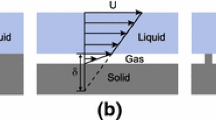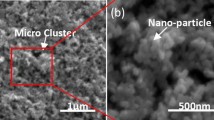Abstract
To design a surface with large slip or larger drag reduction is a pop issue in the fields of liquid transporting and body swimming. In this context, it is a crucial problem to measure the slip length for these surfaces. Here we propose a novel method by using rheometer for this objective. This method is implemented by designing the distribution of the super-hydrophobic area on the sample. Using this method, a slip length of 40 μm for 70 wt% glycerin flow over a super-hydrophobic surface with stripe structure (the period, width and height of ridges are 150 μm, 40 μm and 65 μm, respectively) is measured. The result shows that the slip length measured using this method is in good agreement with former results measured by other methods. This method is fit for measuring the slip length of super-hydrophobic surface whose structure ranges from micro- to nano-scale.
Similar content being viewed by others
References
Lauga E, Brenner M P, Stone H A. Microfluidics: The no-slip boundary condition. Handbook of Experimental Fluid Dynamics. NewYork: Springer, 2005
Luk S, Mutharasan R, Apelianff D. Experimental observations of wall slip: tube and packed bed flow. Ind Eng Chem Res, 1987, 26: 1609–1616
Lee Y-B, Kwaka H-D, Kima C-H, et al. Numerical prediction of slip flow effect on gas-lubricated journal bearings for MEMS/MST-based micro-rotating machinery. Tribol Int, 2005, 38: 89–96
Nie X, Doolen G D, Chen S. Lattice-Boltzmann simulations of fluid flows in MEMS. J Stat Phys, 2002, 107: 279–289
Bocquet L, Barrat J L. Flow boundary conditions from nano- to micro-scales. Soft Matter, 2007, 3: 685–693
Wu C W, Ma G J. Abnormal behavior of a hydrodynamic lubrication journal bearing caused by wall slip. Tribol Int, 2005, 38: 492–499
Choo J H, Glovnea R P, Forrest A K, et al. A low friction bearing based on liquid slip at the wall. J Tribol-T ASME, 2007, 129: 611–620.
Zhang Y. Contact-fluid interfacial slippage in hydrodynamic lubricated contacts. J Mol Liq, 2006, 128: 99–104
Ma G J, Wu C W, Zhou P. Influence of wall slip on the hydrodynamic behaviour of a two-dimensional slider bearing. Acta Mech Sin, 2007, 23: 655–661
Ybert C, Barentin C, Cottin-Bizonne C, et al. Achieving large slip with superhydrophobic surfaces: scaling laws for generic geometries. Phys Fluids, 2007, 19: 123601
Lee C, Choi C-H, Kim C-J. Structured surfaces for a giant liquid slip. Phys Rev Lett, 2008, 101: 064501
Zhu Y, Granick S. Rate-dependent slip of newtonian liquid at smooth surfaces. Phys Rev Lett, 2001, 87: 096105
Baudry J, Charlaix E, Tonck A, et al. Experimental evidence for a large slip effect at a nonwetting fluid-solid interface. Langmuir, 2001, 17: 5232–5236
Bonaccurso E, Michael K, Butt H J. Hydrodynamic force measurements: Boundary slip of water on hydrophilic surfaces and electrokinetic effects. Phys Rev Lett, 2002, 88: 076103
Fan T H, Vinogradova O I. Hydrodynamic resistance of close-approached slip surfaces with a nanoasperity or an entrapped nanobubble. Phys Rev E, 2005, 72: 066306
Tretheway D C, Meinhart C D. A generating mechanism for apparent fluid slip in hydrophobic microchannels. Phys Fluids, 2004, 16: 1509–1515
Zhang X H, Hu J. Nanobubbles at the solid/water interface (in Chinese). Prog Chem, 2004, 16: 673–681
Yang S J, Dammer S M, Bremond N, et al. Characterization of nanobubbles on hydrophobic surfaces in water. Langmuir, 2007, 23: 7072–7077
Wu Z H, Zhang X H, Zhang X D, et al. In situ AFM observation of BSA adsorption on HOPG with nanobubble. Chinese Sci Bull, 2007, 52: 1913–1919
Hammond P T. Form and function in multilayer assembly: New applications at the nanoscale. Adv Mater, 2004, 16: 1271–1293
Genzer J, Efimenko K. Creating long-lived superhydrophobic polymer surfaces through mechanically assembled monolayers. Science, 2000, 290: 2130–2133
Tadanage K, Katata N, Minami T. Super-water-repellent Al2O3 coating films with high transparency. J Am Ceram Soc, 1997, 80: 1040–1042
Michael T, Ralf F, Sylvia S, et al. Generation of ultrahydrophobic properties of Aluminium — A first step to self-cleaning transparently coated metal surfaces. Adv Eng Mater, 2001, 3: 691–695
Tretheway D C, Meinhart C D. Apparent fluid slip at hydrophobic microchannel walls. Phys Fluids, 2002, 14: L9–L12
Ou J, Perot B, Rothstein J P. Laminar drag reduction in microchannels using ultrahydrophobic surfaces. Phys Fluids, 2004, 16: 4635–4643
Pit R, Hervet H, Léger L. Direct experimental evidence of slip in Hexadecane: Solid interfaces. Phys Rev Lett, 2000, 85: 980–983
Choi C H, Kim C J. Large slip of aqueous liquid flow over a nanoengineered superhydrophobic surface. Phys Rev Lett, 2006, 96: 066001
Bocquet L, Tabeling P, Manneville S. Comment on “large slip of aqueous liquid flow over a nanoengineered superhydrophobic surface”. Phys Rev Lett, 2006, 97: 109601
Navier C L M H. M’emoire sur les lois du mouvement des fluides. 1823, Mémoires de l’Académie Royale des Sciences de l’Institut de France, 6: 389–440
Gogte S, Vorobieff P, Truesdell R, et al. Effective slip on textured superhydrophobic surfaces. Phys Fluids, 2005, 17: 051701
Lauga E, Stone H A. Effective slip in pressure-driven Stokes flow. J Fluid Mech, 2003, 489: 55–77
Journet C, Moulinet S, Ybert C, et al. Contact angle measurements on superhydrophobic carbon nanotube forests: Effect of fluid pressure. EPL-Europhys Lett, 2005, 71: 104–110
Zheng L, Wu X, Lou Z, et al. Superhydrophobicity from micro-structured surface. Chinese Sci Bull, 2004, 49: 1779–1787
Author information
Authors and Affiliations
Corresponding author
Additional information
Supported by the Foundation for the Author of National Excellent Doctoral Dissertation of China (Grant No.2006039) and Key Research Foundation of the National Natural Science Foundation of China (Grant No. 50435030)
About this article
Cite this article
Li, J., Zhou, M., Cai, L. et al. On the measurement of slip length for liquid flow over super-hydrophobic surface. Chin. Sci. Bull. 54, 4560–4565 (2009). https://doi.org/10.1007/s11434-009-0577-5
Received:
Accepted:
Published:
Issue Date:
DOI: https://doi.org/10.1007/s11434-009-0577-5




